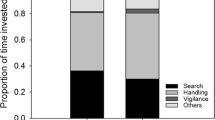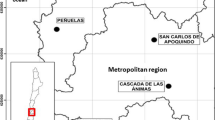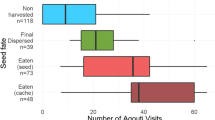Abstract
We examine whether different guilds of foragers remove seeds differentially according to seed quality (seed size and insect infestation) and seed location (habitat and microhabitat) in a mixed oak-beech forest. Video recordings indicated that the wood mouse (Apodemus sylvaticus) was first to encounter seeds. Foragers preferred acorns to beechnuts, large to small size and sound to infested. Nevertheless, infested seeds were removed by rodents even when sound seeds were present. Seeds that were not preferred by scatter-hoarding rodents remained longer on the ground and were more vulnerable to predation and desiccation (4% moisture loss per day). However, seeds that were removed by scatter-hoarders were moved away from their mother trees (96%) and cached individually (32%), increasing their moisture content (3% per day). Buried seeds, simulating scatter-hoarding behavior, experienced only a 17% removal after 4 months. Seed removal differences among habitats were not due to habitat attributes but to the spatial distribution of rodent-preferred microhabitats. Thus, a significant lower seed removal was observed under the tree canopy with no shrubs. However, seed removal in forest gaps with deadwood cover was not significantly different from the preferred microhabitat (under shrub cover). In pure beech forests, seed removal by rodents only occurred under Ilex aquifolium (the only perennial cover) and under woody debris. This study concludes that seed quality and seed location determine the contribution of different removers (predators vs. dispersers), their seed selection and their removal speed, leading to different seed fates which will eventually affect tree regeneration.





Similar content being viewed by others
References
Alonso J (2001) Inventario forestal del sitio natural de interés nacional Hayedo de Montejo de La Sierra, monte no 89 del C.U.P. El Chaparral y La Solana. Comunidad de Madrid
Bonal R, Muñoz A, Díaz M (2007) Satiation of predispersal seed predators: the importance of considering both plant and seed level. Evol Ecol 21:367–380
Branco M, Branco C, Merouani H, Almeida MH (2002) Germination success, survival and seedling vigour of Quercus suber acorns in relation to insect damage. For Ecol Manage 166:159–164
Crawley MJ (2007) The R book. Wiley Editorial, England
Crawley MJ, Long CR (1995) Alternate bearing, predator satiation and seedling recruitment in Quercus robur L. J Ecol 83:683–696
Crow TR (1988) Reproductive mode and mechanisms for self-replacement of northern red oak (Quercus-rubra)—a review. For Sci 34:19–40
Den Ouden J, Jansen PA, Smit R (2005) Jays, mice and oaks: Predation and dispersal of Quercus robur and Q.petraea in North-western Europe. In: Forget PM, Lambert J, Vander Wall SB (eds) Seed fate. CABI Publishing, Wallingford, pp 223–240
Gómez JM (2003) Spatial patterns in long-distance dispersal of Quercus ilex acorns by jays in a heterogeneous landscape. Ecography 26:573–584
Gómez JM, García D, Zamora R (2003) Impact of vertebrate acorn-and seedling-predators on a Mediterranean Quercus pyrenaica forest. For Ecol Manage 180:125–134
Gómez JM, Puerta-Piñeiro C, Schupp EW (2008) Effectiveness of rodents as local seed dispersers of Holm oaks. Oecologia 155:529–537
Gosling PG (1989) The effect of drying Quercus robur acorns to different moisture contents, followed by storage, either with or without imbibition. Forestry 62:41–50
Herrera CM (2002) Seed dispersal by vertebrates. In: Herrera CM, Pellmyr O (eds) Plant-animal interactions. An evolutionary approach. Blackwell, Oxford, pp 185–208
Herrera J (1995) Acorn predation and seedling production in a low-density population of cork oak (Quercus suber L.). For Ecol Manage 76:197–201
Hooper ER, Legendre P, Condit R (2004) Factors affecting community composition of forest regeneration in deforested, abandoned land in Panama. Ecology 85:3313–3326
Hulme PE (1994) Post-dispersal seed predation in grasslands: its magnitude and sources of variation. J Ecol 82:645–652
Hulme PE, Borelli T (1999) Variability in post-dispersal seed predation in deciduous woodland: relative importance of location, seed species, burial and density. Plant Ecol 145:149–156
Hulme PE, Kollmann J (2005) Seed predator guilds, spatial variation in post-dispersal seed predation and potential effects on plant demography. In: Forget PM, Lambert J, Vander Wall SB (eds) Seed fate. CABI Publishing, Wallingford, pp 9–30
Hutchins HE, Hutchins SA, Liu BW (1996) The role of birds and mammals in Korean pine (Pinus koraensis) regeneration dynamics. Oecologia 107:120–130
Janzen D (1971) Seed predation by animals. Annu Rev Ecol Syst 2:465–492
Jensen TS, Nielsen OF (1986) Rodents as seed dispersers in a heath-oak wood succession. Oecologia 70:214–221
Kelbel P (1999) Results of monitoring of carpophagus fauna on the European beech (Fagus sylvatica) in Slovakia. J For Sci 45:443–448
Manson RH, Stiles EW (1998) Links between microhabitat preferences and seed predation by small mammals in old fields. Oikos 82:37–50
Muñoz A, Bonal R (2008) Seed choice by rodents: learning or inheritance? Behav Ecol Sociobiol 62:913–922
Pardo F, Gil L, Pardos JA (2004) Structure and composition of pole-stage stands developed in an ancient wood pasture in central Spain. Forestry 77:67–74
Perea R, San Miguel A, Gil L (2011) Leftovers in seed dispersal: ecological implications of partial seed consumption for oak regeneration. J Ecol 99:194–201
Pérez-Ramos IM, Marañón T (2008) Factors affecting post-dispersal seed predation in two coexisting oak species: microhabitat, burial and exclusion of large herbivores. For Ecol Manage 255:3506–3514
Pons J, Pausas JG (2007) Rodent acorn selection in a Mediterranean oak landscape. Ecol Res 22:535–541
Price MV, Joyner JW (1997) What resources are available to desert granivores: seed rain or soil seed bank? Ecology 78:764–773
Pulido FJ, Díaz M (2005) Regeneration of a Mediterranean oak: a whole-cycle approach. Ecoscience 12:92–102
Sonesson LK (1994) Growth and survival after cotyledon removal in Quercus robur seedlings, grown in different natural soil types. Oikos 69:65–70
Steele MA, Hadj-Chikh LZ, Hazeltine J (1996) Caching and feeding decisions by Sciurus carolinensis: responses to weevil-infested acorns. J Mammal 77:305–314
Suszka B, Tylkowski T (1980) Storage of acorns of the English oak (Quercus robur L.) over 1–5 winters. Arboretum Kórnickie 25:199–229
Valbuena-Carabaña M, González Martínez SC, Sork VL, Collada C, Soto A, Goicoechea PG, Gil L (2005) Gene flow and hybridisation in a mixed oak forest (Quercus pyrenaica Willd. and Quercus petraea (Matts.) Liebl. in central Spain. Heredity 95:457–465
Vander Wall SB (2001) The evolutionary ecology of nut dispersal. Bot Rev 67:74–117
Vander Wall SB, Kuhn KM, Beck MJ (2005) Seed removal, seed predation, and secondary dispersal. Ecology 86:801–806
Xiao ZS, Zhang ZB, Whang YS (2005) Effects of seed size on dispersal distance in five rodent-dispersed fagaceous species. Acta Oecol 28:221–229
Xiao ZS, Jansen PA, Zhang ZB (2006) Using seed-tagging methods for assessing post-dispersal seed fate in rodent-dispersed trees. For Ecol Manage 223:18–23
Xiao ZS, Harris MK, Zhang ZB (2007) Acorn defenses to herbivory from insects: Implications for the joint evolution of resistance, tolerance and escape. For Ecol Manage 238:302–308
Acknowledgments
We would like to thank Steve B. Vander Wall for numerous suggestions and corrections, Christopher Moore for his English corrections and assistance with some of the figures, Mariana Fernández for valuable comments and help on data analysis and Jesús Alonso for his fieldwork assistance. Ramón Perea is supported by a PhD grant from Universidad Politécnica de Madrid. This study was funded by the project REGENFOR-CM (S2009AMB-1668) of Comunidad Autónoma de Madrid and the project AGL2006-00813 of the Spanish CICYT.
Author information
Authors and Affiliations
Corresponding author
Additional information
Communicated by C. Ammer.
Rights and permissions
About this article
Cite this article
Perea, R., San Miguel, A., Martínez-Jauregui, M. et al. Effects of seed quality and seed location on the removal of acorns and beechnuts. Eur J Forest Res 131, 623–631 (2012). https://doi.org/10.1007/s10342-011-0536-y
Received:
Revised:
Accepted:
Published:
Issue Date:
DOI: https://doi.org/10.1007/s10342-011-0536-y




